Lessico
Oleandro
Nerium oleander
L'oleandro (Nerium oleander L., 1753), è detto nërion in greco, derivato da nërós che significa fresco, umido, in quanto amerebbe crescere ai bordi dei ruscelli. Oleander deriva invece dal latino olea, l'ulivo, in quanto le foglie sono permanenti come quelle dell'ulivo e ne ricordano la foggia. L'oleandro è un arbusto sempreverde appartenente alla famiglia delle Apocynaceae. È forse originario dell'Asia ma è naturalizzato e spontaneo nelle regioni mediterranee e diffusamente coltivato a scopo ornamentale.
L'oleandro ha un portamento arbustivo, con fusti generalmente poco ramificati che partono dalla ceppaia, dapprima eretti, poi arcuati verso l'esterno. I rami giovani sono verdi e glabri. I fusti e i rami vecchi hanno una corteccia di colore grigiastro.
Le foglie sono glabre e coriacee, disposte a verticilli di 2-3, brevemente picciolate, con margine intero e nervatura centrale robusta e prominente. La lamina è lanceolata, acuta all'apice, larga 1-2 cm e lunga 10-14 cm.
I fiori sono grandi e vistosi, a simmetria raggiata, disposti in cime terminali. Il calice è diviso in cinque lobi lanceolati, di colore roseo o bianco nelle forme spontanee. La corolla è tubulosa e poi suddivisa in 5 lobi, di colore variabile dal bianco al rosa al rosso carminio. Le varietà coltivate sono a fiore doppio. L'androceo è formato da 5 stami, con filamenti saldati al tubo corollino. L'ovario è supero, formato da due carpelli pluriovulari. La fioritura è abbondante e scalare, ha inizio nei mesi di aprile o maggio e si protrae per tutta l'estate fino all'autunno.
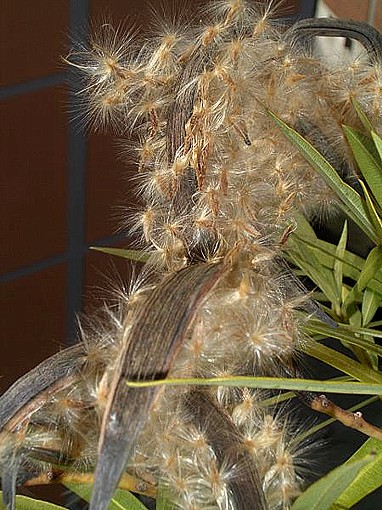
Il frutto è un follicolo fusiforme, stretto e allungato, lungo 10-15 cm. A maturità si apre longitudinalmente lasciando fuoriuscire i semi. Il seme ha dimensione variabile dai 3 ai 5 mm di lunghezza e circa 1 mm di diametro ed è sormontato da una peluria disposta ad ombrello (pappo) che permette al seme di essere trasportato dal vento anche per lunghe distanze.
L'oleandro è una specie termofila ed eliofila, abbastanza rustica. Trae vantaggio dall'umidità del terreno rispondendo con uno spiccato rigoglio vegetativo, tuttavia ha caratteri xerofitici dovuti alla modificazione degli stomi fogliari che gli permettono di resistere a lunghi periodi di siccità. Teme il freddo, pertanto in ambienti freddi fuori dalla sua zona fitoclimatica deve essere posto in luoghi riparati e soleggiati. Viene coltivato in tutta Italia a scopo ornamentale e spesso è usato lungo le strade perché non richiede particolari cure colturali.
Nonostante il portamento cespuglioso per natura, può essere allevato ad albero per realizzare viali alberati suggestivi per la fioritura abbondante, lunga e variegata nei colori. In questo caso richiede frequenti interventi di spollonatura per rimuovere i polloni basali emessi dalla ceppaia.
L'oleandro ha un areale piuttosto vasto che si estende nella fascia temperata calda dal Giappone al bacino del Mediterraneo. In Italia vegeta spontaneamente nella zona fitoclimatica del Lauretum presso i litorali, inoltrandosi all'interno fino ai 1000 metri d'altitudine lungo i corsi d'acqua. In effetti si tratta di un elemento comune e inconfondibile della vegetazione riparia degli ambienti mediterranei, quasi sempre associato ad altre specie riparie quali l'ontano, il tamerice, l'agno casto. S'insedia sia sui suoli sabbiosi alla foce dei fiumi o lungo la loro riva, sia sui greti sassosi, formando spesso una fitta vegetazione.
L'associazione vegetale riparia con una marcata presenza dell'oleandro è una particolare cenosi vegetale che prende il nome di Macchia ad oleandro e agno casto, di estensione limitata. Si tratta di una naturale prosecuzione dell'Oleo-ceratonion, dal momento che le due cenosi gradano l'una verso l'altra con associazioni intermedie che vedono contemporaneamente la presenza dell'oleandro e di elementi tipici della macchia termoxerofila (lentisco, carrubo, mirto, ecc.). Un caso singolare, forse unico in natura, si rinviene nella Gola di Su Gorropu fra il Supramonte di Orgosolo e quello di Urzulei in Sardegna: in questo caso la macchia ad oleandro e agno casto si inoltra fino ai 1000 metri confinando con la lecceta primaria.
L'oleandro fa parte delle piante che contengono cardenolidi. Tutta la pianta è tossica per qualsiasi specie animale. Se ingerita porta a tachicardia con aumento della frequenza respiratoria. Responsabile di questa estrema tossicità è l'oleandrina, un glicoside cardiotossico.
Le specie animali più colpite sono gli equini, i bovini e i piccoli carnivori. Nel cavallo abbiamo anche la comparsa di gravi e profonde lesioni a livello della mucosa orale. La morte sopraggiunge per collasso cardio-respiratorio solo nel caso in cui se ne ingeriscano grandi quantità.
L'oleandro è oggetto di regalo e metafora della vita nel film Il pesce innamorato di Leonardo Pieraccioni.
Le sue proprietà tossiche sono state usate come "arma" per l'omicidio descritto nel film White Oleander. Al riguardo la storia racconta che diversi soldati delle truppe napoleoniche morirono per avvelenamento dopo aver usato rami di oleandro come spiedi nella cottura della carne alla brace, durante le campagne militari in Italia.
foto Elio Corti - 2001
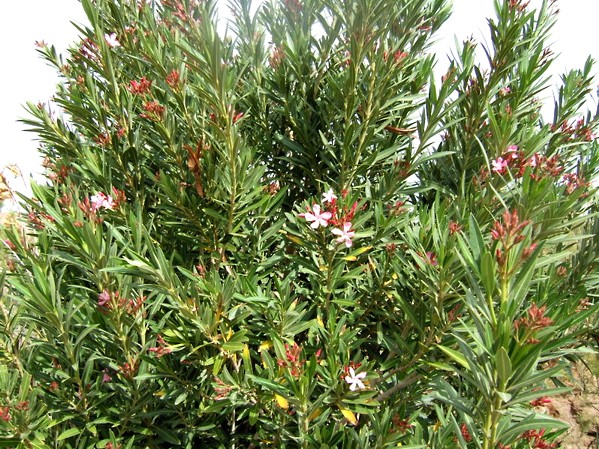
Oleander (Nerium oleander), is a evergreen shrub or small tree in the dogbane family Apocynaceae. It is the only species currently classified in the genus Nerium. Other names include Adelfa, Alheli Extranjero, Baladre, Espirradeira, Flor de São Jose, Laurel de jardín, Laurel rosa, Laurier rose, Flourier rose, Olean, Aiwa, Rosa Francesca, Rosa Laurel, and Rose-bay (Inchem 2005), Araliya (in Sinhalese); in Chinese it is known as jia zhu tao. The ancient city of Volubilis in North Africa took its name from the old Latin name for the flower.
It is native to a broad area from Morocco and Portugal eastward through the Mediterranean region and southern Asia to Yunnan in southern parts of China (Flora Europaea; Flora of China; Huxley et al. 1992; www.inchem.org). It typically occurs around dry stream beds. It grows to 2-6 m tall, with spreading to erect branches. The leaves are in pairs or whorls of three, thick and leathery, dark green, narrow lanceolate, 5-21 cm long and 1-3.5 cm broad, and with an entire margin. The flowers grow in clusters at the end of each branch; they are white, pink or yellow, 2.5-5 cm diameter, with a deeply 5-lobed corolla with a fringe round the central corolla tube. They are often, but not always, sweetly scented. The fruit is a long narrow capsule 5-23 cm long, which splits open at maturity to release numerous downy seeds.
In the past, scented plants were sometimes treated as a distinct species Nerium odorum, but the character is not constant and it is no longer regarded as a separate taxon.
Oleander grows well in warm subtropical regions, where it is extensively used as an ornamental plant in landscapes, parks, and along roadsides. It is drought tolerant and will tolerate occasional light frost down to -10°C (Huxley et al. 1992). It can also be grown in cooler climates in greenhouses, conservatories, or as indoor plants that summer outside. Oleander flowers are showy and fragrant and are grown for these reasons. Over 400 cultivars have been named, with several additional flower colours not found in wild plants having been selected, including red, purple and orange; white and a variety of pinks are the most common. Many cultivars also have double flowers. Young plants grow best in spaces where they do not have to compete with grass for nutrients.
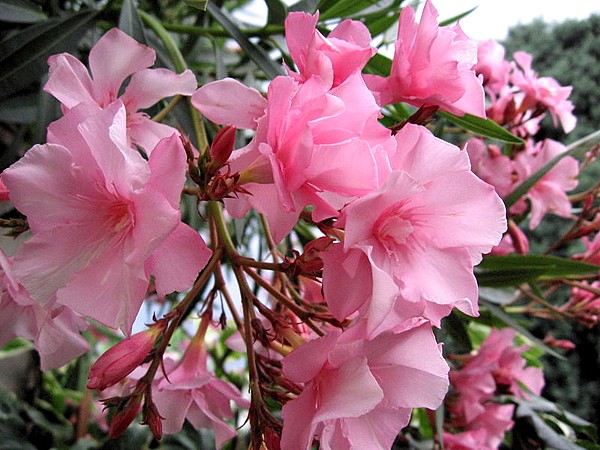
Oleander is one of the most poisonous plants and contains numerous toxic compounds, many of which can be deadly to people, especially young children. The toxicity of Oleander is considered extremely high and it has been reported that in some cases only a small amount had lethal or near lethal effects (Goetz 1998). The most significant of these toxins are oleandrin and neriine, which are cardiac glycosides (Goetz 1998). "Cardiac glycocides are naturally occurring" plant or animal compounds "whose actions include both beneficial and toxic effects on the heart" (Desai 2000). They are present in all parts of the plant, but are most concentrated in the sap. It is thought that Oleander may contain many other unknown or un-researched compounds that may have dangerous effects (Inchem 2005). Oleander bark contains rosagenin which is known for its strychnine-like effects. The entire plant including the milky white sap is toxic and any part can cause an adverse reaction. Oleander is also known to hold its toxicity even after drying. It is thought that a handful or 10-20 leaves consumed by an adult can cause an adverse reaction, and a single leaf could be lethal to an infant or child. According to the Toxic Exposure Surveillance System (TESS) in 2002 there were 847 known human poisonings in the United States related to Oleander (Watson 2003). There are innumerable reported suicidal cases of consuming mashed oleander seeds in South India. In animals, around 0.5 mg per kilogram of body weight is lethal to many animals, and various other doses will affect other animals (Inchem 2005). Most animals can suffer a reaction or death from this plant.
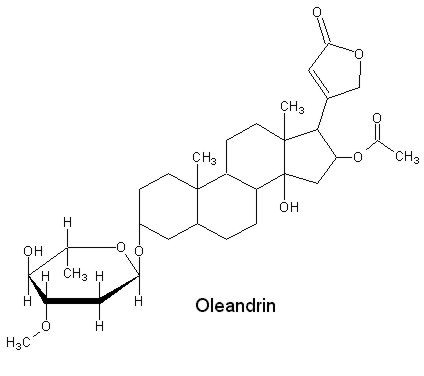
Oleandrin, one of the toxins present in Oleander.
Reactions to this plant are as follows. Ingestion can cause both gastrointestinal and cardiac effects. The gastrointestinal effects can consist of nausea and vomiting, excess salivation, abdominal pain, diarrhoea that may or may not contain blood, and especially in horses, colic (Inchem 2005). Cardiac reactions consist of irregular heart rate, sometimes characterized by a racing heart at first that then slows to below normal further along in the reaction. The heart may also beat erratically with no sign of a specific rhythm. Extremities may become pale and cold due to poor or irregular circulation (Goetz 1998). Reactions to poisonings from this plant can also affect the central nervous system. These symptoms can include drowsiness, tremors or shaking of the muscles, seizures, collapse, and even coma that can lead to death (Goetz 1998). Oleander sap can cause skin irritations, severe eye inflammation and irritation, and allergy reactions characterized by dermatitis (Goetz 1998).
Poisoning and reactions to Oleander plants are evident quickly, requiring immediate medical care in suspected or known poisonings of both humans and animals (Goetz 1998). Induced vomiting and gastric lavage are protective measures to reduce absorption of the toxic compounds. Charcoal may also be administered to help absorb any remaining toxins (Inchem 2005). Further medical attention may be required and will depend on the severity of the poisoning and symptoms.
Drying of plant materials does not eliminate the toxins. It is also hazardous for animals such as sheep, horses, cattle, and other grazing animals, with as little as 100 g being enough to kill an adult horse (Knight 1999). Plant clippings are especially dangerous to horses, as they are sweet. Symptoms of a poisoned horse include severe diarrhoea and abnormal heartbeat. There are a wide range of toxins and secondary compounds within Oleander, and care should be taken around this plant due to its toxic nature. Different names for Oleander are used around the world in different locations (see top of page); so when encountering a plant with this appearance, regardless of the name used for it, exercise great care and caution to avoid ingestion of any part of the plant, including its sap and dried leaves or twigs. Do not use the dried or fresh branches for spearing food, in preparing a cooking fire, or as a food skewer. Many of the Oleander relatives, such as the Desert Rose (Adenium obesum) found in East Africa, have similar leaves and flowers and are equally toxic.
While the reasons are unknown, some visibly healthy oleander shrubs that have become sick or otherwise diseased may generate a type of oil from the trunk and shallow roots. Depending upon the size of the shrub, the oil quantity can vary greatly and has the capability to saturate the soil in its vicinity as the shrub's sickness progresses. This is possibly an explanation for the plant's name of "Olea", whose Latin translation is "oil". The oil is light-brown colored and possesses a rancid scent. The toxicity of the oil is unknown, because the neuro-toxic chemicals in the rest of the tree come from the leave's vein-system and not from the actual pulp surrounding these veins. There is even a species of large, green caterpillar who feeds specifically on oleanders and survives by eating only the pulp surrounding the leaf-veins, avoiding the fibers.
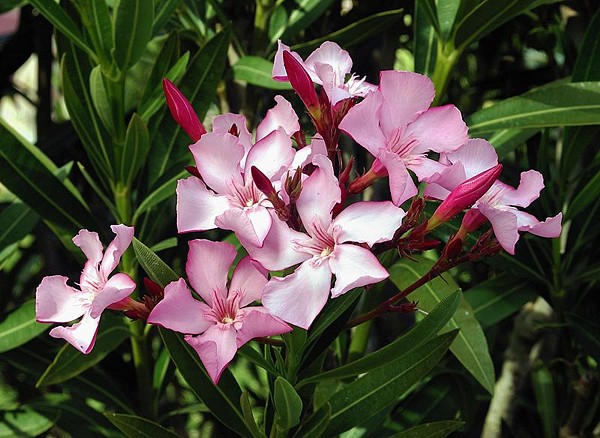
Pliny
the Elder in his Naturalis Historia written circa AD 77 claimed that despite
its toxicity it was an effective snakebite cure: "...if taken in wine
with rue..." .
An extract "Anvirzel" has been developed completed Phase I testing
in 2000 to judge its effectiveness as a cancer treatment. Despite such trial
not yet showing benefits[ this and a range of other Oleander-based treatments
are being promoted on the Internet and in some alternative medicine circles,
drawing warning letter from the FDA in the US.